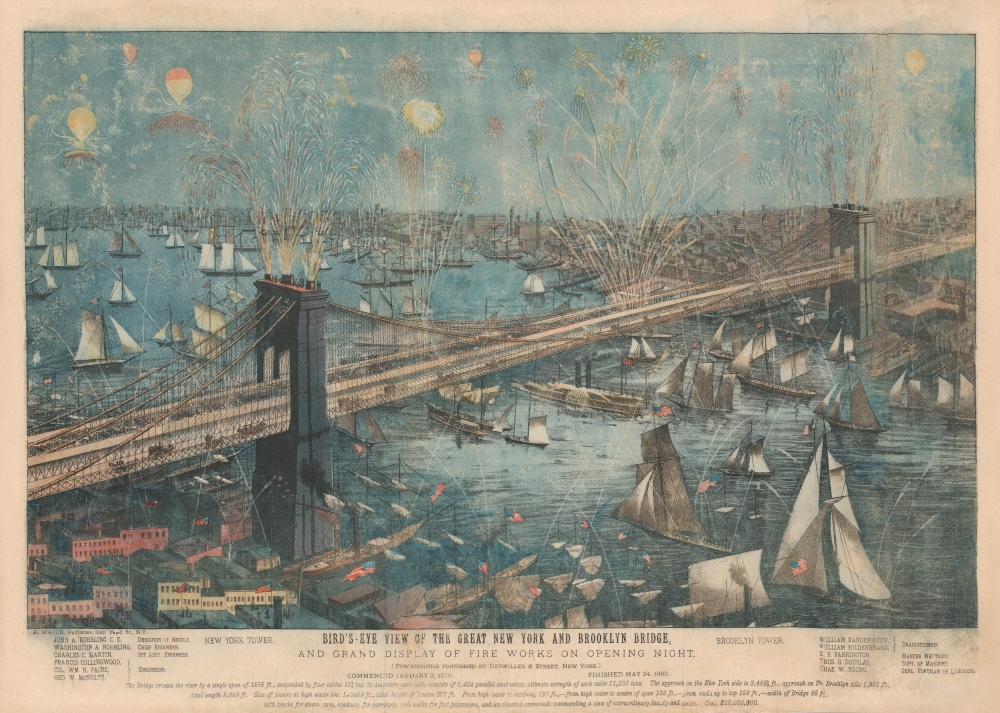This item has been sold, but you can get on the Waitlist to be notified if another example becomes available, or purchase a digital scan.
1883 Major Bird's-Eye View of the Brooklyn Bridge Opening Night (New York)
BirdsEyeBrooklynBridge-major-1883-2
Title
1883 (dated) 17.75 x 25.25 in (45.085 x 64.135 cm)
Description
Opening Day Celebrations
Opened May 24, 1883, thousands attended the New York and Brooklyn Bridge opening ceremony. Emily Warren Roebling (1843 - 1903), Washington Roebling's (1837 - 1926) wife and John A. Roebling's (1806 - 1869) daughter-in-law, was the first to cross. President Chester A. Arthur (1829 - 1886) attended the ceremony, and New York mayor Franklin Edson (1832 - 1904) crossed the bridge to shake hands with Brooklyn mayor Seth Low (1815 - 1916). Washington Roebling, the chief engineer of the project after his father's death, did not attend the ceremony but held a banquet at his house that evening. Other festivities included the dramatic fireworks display, as here, and a band concert. 1,800 vehicles and 150,300 people crossed the bridge that day.Chromolithography
Chromolithography is a color lithographic technique developed in the mid-19th century. The process involved using multiple lithographic stones, one for each color, to yield a rich composite effect. Oftentimes, the process would start with a black basecoat upon which subsequent colors were layered. Some chromolithographs used 30 or more separate lithographic stones to achieve the desired effect. Chromolithograph color could also be effectively blended for even more dramatic results. The process became extremely popular in the late 19th and early 20th centuries, when it emerged as the dominate method of color printing. The vivid color chromolithography produced made it exceptionally effective for advertising and propaganda imagery.Publication History and Census
This view was drawn by an unknown artist and published by A. Major in 1883. Examples are part of the collection at the Metropolitan Museum of Art, the Brooklyn Museum, and the Museum of the City of New York. It is not cataloged in OCLC. Exceedingly rare with no record on the private market.Cartographer
Alfred Sarony Major (April 13, 1854 - July 23, 1929) was a New York City publisher, engraver, and lithographer. Major was born in New York, the son of Henry Broughman Major (1820 - 1887), of the lithography firm 'Sarony, Major, Knapp'. His middle name honors Napoleon Sarony (1821 - 1896), his father's business partner and a major pioneer in American lithography. Major learnt lithography under his father, Henry S. Major, at Major and Knapp. Major's early independent work is extremely obscure, being a singular view of the opening ceremonies of the Brooklyn Bridge issued in 1883. At the time, Major's offices were located at 330 Pearl Street, right next to the Manhattan entrance to the Bridge, in South Street Seaport, suggesting the location may have been a short-term marriage of convenience. Later he became a 'major' figure in publishing, the Vice-President of the American Banknote Company, one of the largest printers in the United States. In his later years, Major focused his attentions fully on engraving, becoming renowned as one of the finest banknote engravers in the world. More by this mapmaker...

